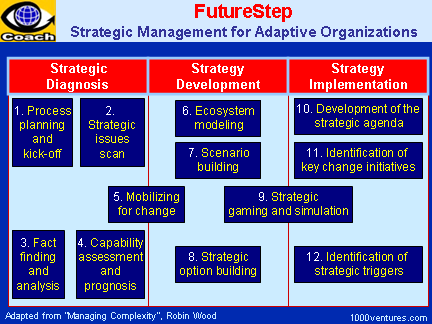
|
Benefits Enjoyed by Organizations
Practicing FutureStep |
|
Enhanced
organizational intelligence,
shown by improved decision quality and accelerated learning
capability.
Greater clarity and robustness in
strategic direction, with reduced risk;
Increased
adaptiveness,
speed and
flexibility in
responding appropriately to change;
Improved organizational design in
which the shape or form of the organization mirrors its function and
embodies its own
transformational capabilities;
Stakeholder alignment around a
shared, sustainable model of the business ecosystem with which the organization co-evolves. |
|
What Is FutureStep?
FutureStep is a new
strategic management process that helps companies, especially large
multinational
adaptive organizations, integrate
flexibility and responsiveness into every aspect of their activities. It is
modular tool, and parts can be used independently or as a complete program
for guiding strategic decision making.
|
Why FutureStep?
"Effective
managers live in the present – but concentrate on the future."
~
James L. Hayes
The FutureStep process is aimed at enabling
organizations to meet the challenges of navigating a complex and uncertain
future environment, by helping them to evolve as complex, intelligence
systems. It focuses on what an organization can do in the present to
increase its ability to
operate in a sustainable way in the future.
Background
This approach to strategic management evolved
through many years of practical experience with multinational organizations
in several industries in Europe, North America and Asia. Organizations that
have pioneered this kind of approach to strategic management include 3M,
British Telecom (BT), the British National Health Service, Dutch Telecom,
Hewlett-Packard, Jardine Matheson, Shell, State Farm Insurance, and the US
Department of Defense.
|
|
"In the case of complex adaptive systems, their schemata have consequences
in the real world, which exert selection pressures back on the competition
among the schemata, and those schemata that produce favorable results in the
real world have a tendency to survive, or be promoted, and those that are
less successful in the real world have a tendency to be demoted or
disappear. In many situations, complexity may offer a selective advantage."
~ Murray
Gell-Mann
|